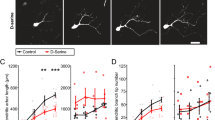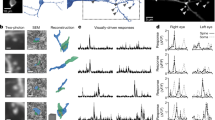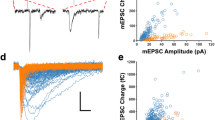Abstract
Acidic amino acids, such as glutamate and aspartate, are thought to be excitatory transmitters in the cerebral neocortex and hippocampus1–8. Receptors for these amino acids can be classified into at least three types on the basis of their agonists. Quisqualate-preferring receptors and kainate-preferring receptors are implicated in the mediation of synaptic transmission in many regions including the hippocampus9,10 and visual cortex11, whereas N-methyl-D-aspartate (NMDA)-preferring receptors are thought to be involved in modulating synaptic efficacy, for example in long-term potentiation, a form of synaptic plasticity in the hippocampus12–14. In the visual cortex of the cat and monkey, it is well established that synaptic plasticity, estimated by susceptibility of binocular responsiveness of cortical neurons to monocular visual deprivation, disappears after the 'critical' period of postnatal development15–17. Here we report that during the critical period in young kittens, a selective NMDA-receptor antagonist blocks visual responses of cortical neurons much more effectively than it does in the adult cat. This suggests that NMDA receptors may be involved in establishing synaptic plasticity in the kitten visual cortex.
This is a preview of subscription content, access via your institution
Access options
Subscribe to this journal
Receive 51 print issues and online access
$199.00 per year
only $3.90 per issue
Buy this article
- Purchase on Springer Link
- Instant access to full article PDF
Prices may be subject to local taxes which are calculated during checkout
Similar content being viewed by others
References
1. Hayashi, T. Keio J. Med. 3, 183–192 (1954). 2. Krnjevic, K. & Phillis, J. W. /. Physiol., Lond. 165, 274–304 (1963). 3. Clark, R. M. & Collins, C. G. S. / Physiol., Lond. 262, 383–400 (1976). 4. Baughman, R. W. & Gilbert, C. D. / Neurosci. 1, 427–439 (1981). 5. Tsumoto, T., Masui, H. & Sato, H. / Neurophysiol. 55, 469–483 (1986). 6. Nadler, J. V., Vaca, K., White, W. R, Lynch, G. S. & Cotman, C. W. Nature 260, 538–540 (1976). 7. Nitsh, C. in Amino Acid Neurotransmitters (eds Defeudis, F. V. & Mandel, P.) 97–104 (Raven, New York, 1981). 8. Storm–Mathisen, J. in Glutamate as a Neurotransmitter (eds Di Chiara, G. & Gessa, G. L.) 43–55 (Raven, New York, 1981). 9. Watkins, J. C. & Evans, R. H. A. Rev. Pharmac. Tox. 21, 165–204 (1981). 10. McLennan, H. Prog. Neurobiol. 20, 251–271 (1983). 11. Tsumoto, T., Masui, H. & Sato, H. in Excitatory Amino Acid Transmission (eds Hicks, T. P., Lodge, D. & McLennan, H.) 389–396 (Liss, New York, 1987). 12. Bliss, T. V. P. & Lomo, T. /. Physiol., Lond. 232, 331–356 (1973). 13. Collingridge, G. L., Kehl, S. J. & McLennan, H. J. Physiol., Lond. 334, 19–31 (1983). 14. Harris, E. W., Ganong, A. H. & Cotman, C. W. Brain Res. 323, 132–137 (1984). 15. Hubel, D. H. & Wiesel, T. N. J. Physiol., Lond. 206, 419–436 (1970). 16. Blakemore, C. & Van Sluyters, R. C. J. Physiol., Lond. 237, 195–216 (1974). 17. Von Noorden, G. K. Invest. Ophthalmol. Vis. Sci. 12, 721–726 (1973). 18. Perkins, M. N. & Stone, T. W. Brain Res. 247, 184–187 (1982). 19. Ganong, A. H., Lanthorn, T. H. & Cotman, C. W. Brain Res. 273, 170–174 (1983). 20. Hagihara, K., Tsumoto, T., Sato, H. & Hata, T. in Excitatory Amino Acid Transmission (eds Hicks, T. P., Lodge, D. & McLennan, H.) 409–412 (Liss, New York, 1987). 21. Dingledine, R. J. Physiol, Lond. ?43, 385–405 (1983). 22. Thompson, A. M., West, D. C. & Lodge, D. Nature 313, 479–481 (1985). 23. Salt, T. E. Nature 322, 263–265 (1986). 24. Herron, C. E., Lester, R. A. J., Coan, F. J. & Collingridge, G. L. Nature 322,265–268 (1986). 25. Fagg, G. E., Foster, A. C. & Ganong, A. H. Trends pharmac. Sci. 7, 357–363 (1986). 26. MacDermott, A. B., Mayer, M. L., Westbrook, G. L., Smith, S. J. & Barker, J. L. Nature 321, 519–522 (1986).
Author information
Authors and Affiliations
Rights and permissions
About this article
Cite this article
Tsumoto, T., Hagihara, K., Sato, H. et al. NMDA receptors in the visual cortex of young kittens are more effective than those of adult cats. Nature 327, 513–514 (1987). https://doi.org/10.1038/327513a0
Received:
Accepted:
Issue Date:
DOI: https://doi.org/10.1038/327513a0
This article is cited by
-
The CaMKII/NMDA receptor complex controls hippocampal synaptic transmission by kinase-dependent and independent mechanisms
Nature Communications (2018)
-
Anesthetic ketamine counteracts repetitive mechanical stress-induced learning and memory impairment in developing mice
Molecular Biology Reports (2011)
-
Effect of ketamine administration on memory consolidation, p-CREB and c-fos expression in the hippocampal slices of minor rats
Molecular Biology Reports (2011)
-
Effect of ageing on Ca2+ uptake via NMDA receptors into barrel cortex slices of spontaneously hypertensive rats
Metabolic Brain Disease (2008)
-
Glutamate antagonists are neurotoxins for the developing brain
Neurotoxicity Research (2007)
Comments
By submitting a comment you agree to abide by our Terms and Community Guidelines. If you find something abusive or that does not comply with our terms or guidelines please flag it as inappropriate.



